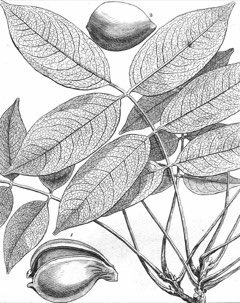 |
|
http://www.edibleplants.org |
 |
| Jean-Pierre Chéreau & Roger Culos wikimedia.org |
Translate this page:
Summary
Vouacapoua americana is a slender, semi deciduous tree growing usually about 35 m tall. It has a roundish crown and a straight, cylindrical, not buttressed trunk that can be up to 90 cm in diameter. It is commonly grown throughout northern South America and currently threatened by overexploitation. Medicinally, the plant is used for body aches, malaria, and fevers. No plant part is edible. The wood is hard, heavy, dense, and highly durable, and suitable for high class furniture, cabinet making, turnery, flooring, wheelwright?s work, beams, general construction, joinery, panelling, etc.
Physical Characteristics

 Vouacapoua americana is an evergreen Tree growing to 25 m (82ft) by 25 m (82ft) at a medium rate.
Vouacapoua americana is an evergreen Tree growing to 25 m (82ft) by 25 m (82ft) at a medium rate.
See above for USDA hardiness. It is hardy to UK zone 10.
It can fix Nitrogen.
Suitable for: medium (loamy) and heavy (clay) soils and prefers well-drained soil. Suitable pH: mildly acid, neutral and basic (mildly alkaline) soils. It can grow in semi-shade (light woodland) or no shade. It prefers moist soil.
UK Hardiness Map
US Hardiness Map
Synonyms
Andira aubletii Benth.
Plant Habitats
Edible Uses
References More on Edible Uses
Medicinal Uses
Plants For A Future can not take any responsibility for any adverse effects from the use of plants. Always seek advice from a professional before using a plant medicinally.
Febrifuge Malaria
A decoction of the wood is used as a wash for body aches caused by overwork[348 ]. A decoction of the bark is drunk to treat malaria[348 ]. A decoction of the leaves is used as a wash for fevers[348 ].
References More on Medicinal Uses
The Bookshop: Edible Plant Books
Our Latest books on Perennial Plants For Food Forests and Permaculture Gardens in paperback or digital formats.

Edible Tropical Plants
Food Forest Plants for Hotter Conditions: 250+ Plants For Tropical Food Forests & Permaculture Gardens.
More

Edible Temperate Plants
Plants for Your Food Forest: 500 Plants for Temperate Food Forests & Permaculture Gardens.
More

More Books
PFAF have eight books available in paperback and digital formats. Browse the shop for more information.
Shop Now
Other Uses
Furniture Wood
Other Uses The heartwood is dark olive to dark chocolate; it is clearly demarcated from the 18 - 30mm wide, cream-coloured sapwood. Numerous fine lines of parenchyma, which are initially lighter brown in colour but which eventually turn nearly black, make the wood unusually attractive. The texture is uniformly coarse; the grain straight to slightly roey; the lustre low; no distinctive odour or taste is present in seasoned wood. The wood is hard, heavy, dense and very durable in contact with the soil, being highly resistant to decay and insect attack. There are conflicting reports regarding its resistance to toredo attack in sea water, though it is generally considered fairly resistant. It is somewhat slow to season, with only a slight risk of checking and distortion; once dry it is moderately stable in service. It has a fairly high blunting effect, so stellite-tipped and tungsten carbide tools are recommended; despite its high density, however, the wood is only moderately difficult to work and is generally said to have good working qualities; smooth surfaces are obtained in sawing and planing, but the coarse grain causes some rough and torn grain in boring and mortising; nailing and screwing are good so long as holes are pre-bored; gluing is correct for interior purposes only. The wood is used for making high class furniture, cabinet making, turnery, flooring, wheelwright's work, beams, general construction, joinery, panelling, railway crossties, posts, rising and gunwales of boats, and general construction[378 , 848 ].
Special Uses
References More on Other Uses
Cultivation details
A plant of low elevations in the moist tropics. Succeeds in full sun to dappled shade[420 ]. Found in the wild mainly on moist, clay soils[420 ]. Newly planted young trees grow away quite quickly and can reach 2 metres or more within 2 years[420 ]. Although many species within the family Fabaceae have a symbiotic relationship with soil bacteria, this species is said to be devoid of such a relationship and therefore does not fix atmospheric nitrogen[755 ].
References Carbon Farming Information and Carbon Sequestration Information
Temperature Converter
Type a value in the Celsius field to convert the value to Fahrenheit:
Fahrenheit:
The PFAF Bookshop
Plants For A Future have a number of books available in paperback and digital form. Book titles include Edible Plants, Edible Perennials, Edible Trees,Edible Shrubs, Woodland Gardening, and Temperate Food Forest Plants. Our new book is Food Forest Plants For Hotter Conditions (Tropical and Sub-Tropical).
Shop Now
Plant Propagation
Seed - it normally germinates within 1 - 2 weeks of falling from the tree so needs to be sown as soon as it is harvested. Sow the seed in individual containers in a semi-shaded position, A germination rate in excess of 80% can be expected within 1 - 2 weeks[420 ]. Plants should be ready to plant into their permanent positions 4 - 5 months later[420 ].
Other Names
If available other names are mentioned here
Native Plant Search
Search over 900 plants ideal for food forests and permaculture gardens. Filter to search native plants to your area. The plants selected are the plants in our book 'Plants For Your Food Forest: 500 Plants for Temperate Food Forests and Permaculture Gardens, as well as plants chosen for our forthcoming related books for Tropical/Hot Wet Climates and Mediterranean/Hot Dry Climates. Native Plant Search
Found In
Countries where the plant has been found are listed here if the information is available
French Guiana; Guyana; Peru; Suriname; Brazil
Weed Potential
Right plant wrong place. We are currently updating this section.
Please note that a plant may be invasive in one area but may not in your area so it’s worth checking.
Conservation Status
IUCN Red List of Threatened Plants Status : Status: Critically Endangered A1cd+2cd

Growth: S = slow M = medium F = fast. Soil: L = light (sandy) M = medium H = heavy (clay). pH: A = acid N = neutral B = basic (alkaline). Shade: F = full shade S = semi-shade N = no shade. Moisture: D = dry M = Moist We = wet Wa = water.

Expert comment
Author
Aubl.
Botanical References
Links / References
For a list of references used on this page please go here
A special thanks to Ken Fern for some of the information used on this page.
Readers comment
| Add a comment |
|
If you have important information about this plant that may help other users please add a comment or link below. Only comments or links that are felt to be directly relevant to a plant will be included. If you think a comment/link or information contained on this page is inaccurate or misleading we would welcome your feedback at [email protected]. If you have questions about a plant please use the Forum on this website as we do not have the resources to answer questions ourselves.
* Please note: the comments by website users are not necessarily those held by PFAF and may give misleading or inaccurate information.
To leave a comment please Register or login here All comments need to be approved so will not appear immediately.
|
Subject : Vouacapoua americana
|
|
|
|